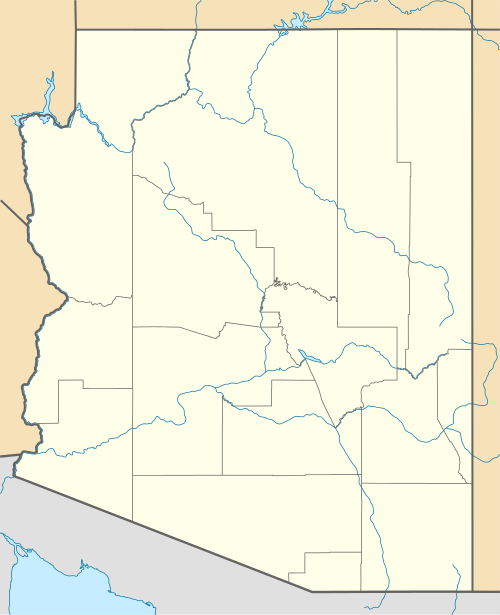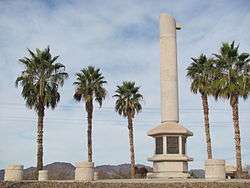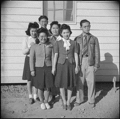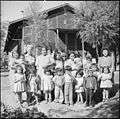Poston War Relocation Center
| Poston War Relocation Center | |
|---|---|
| Detainee camp | |
|
Painting of the Poston War Relocation Center painted by Japanese American Tom Tanaka while interned | |
 Poston War Relocation Center Location of the camp in the state of Arizona | |
| Coordinates: 33°59′15″N 114°24′4″W / 33.98750°N 114.40111°WCoordinates: 33°59′15″N 114°24′4″W / 33.98750°N 114.40111°W | |
| Country | United States |
| State | Arizona |
| Opened | 1942 |
| Closed | 1945 |
| Founded by | War Relocation Authority |
| Population (September, 1942) | |
| • Total | 17,814 |
The Poston War Relocation Center, located in Yuma County (now in La Paz County) of southwestern Arizona, was the largest (in terms of area) of the ten American concentration camps operated by the War Relocation Authority during World War II.
The site was composed of three separate camps arranged in a chain from north to south at a distance of three miles from each other. Internees named the camps Roasten, Toastin, and Dustin, based on their desert locations.[1] The Colorado River was approximately 3 miles (4.8 km) to the west, outside of the camp perimeter.
Poston was built on the Colorado River Indian Reservation, over the objections of the Tribal Council, who refused to be a part of doing to others what had been done to their tribe. However, Army commanders and officials of the Bureau of Indian Affairs overruled the Council, seeing the opportunity to improve infrastructure and agricultural development (which would remain after the war and aid the Reservation's permanent population) on the War Department budget and with thousands of "volunteers."[2]
The combined peak population of the Poston camps was over 17,000, mostly from Southern California. At the time Poston was the third largest "city" in Arizona. It was built by Del Webb, who would later become famous building Sun City, Arizona and other retirement communities. The Poston facility was named after Charles Debrille Poston, a government engineer who established the Colorado River Reservation in 1865 and planned an irrigation system to serve the needs of the Indian people who would live there.[3]
A single fence surrounded all three camps, and the site was so remote that authorities considered it unnecessary to build guard towers.[1] The thousands of internees and staff passed through the barbed-wire perimeter at Poston I, which was where the main administration center was located.
Poston was a subject of a sociological research by Alexander H. Leighton, published in his 1945 book, The Governing of Men. As Time Magazine wrote, "After fifteen months at Arizona's vast Poston Relocation Center as a social analyst, Commander Leighton concluded that many an American simply fails to remember that U.S. Japanese are human beings."[4]
Establishment of the camp
After overriding the Colorado River Reservation's tribal council, the BIA and WRA jointly took control of 71,000 acres (29,000 ha) of tribal land and began construction in early 1942. Dell Webb began building Poston I on March 27, and his workforce of 5,000 completed the first camp less than three weeks later. Construction on II and III began soon after, contracted to be finished within 120 days.[3] In the meantime, Poston was partially opened on May 8, as the Parker Dam Reception Center, one of two such sites that augmented the 15 temporary "assembly centers" where Japanese Americans waited to be transferred to the more permanent WRA camps.[5] Approximately two-thirds of Poston's population were brought directly from their homes to what was then Parker Dam, and many of these early arrivals volunteered to help complete the still under construction camps.[1][3]
Upon completion, the Poston site consisted of hundreds of residential barracks, a hospital, an administrative center, and guard and staff housing. The camp officially opened as the Colorado River Relocation Center on June 1, 1942, and the BIA relinquished its authority over Poston in 1943.[1][5]
Life at Poston


Tensions came to a head in November 1942 sparked by the beating of a suspected informer on Saturday evening November 14.[6] Further beatings and arrests of two suspects inflamed the situation and workers went on strike on November 19. A compromise was reached by the director and the evacuees' Emergency Executive Council, ending the strike on November 24.[7]
Perhaps the frustration felt in the concentration camps was best expressed by this anonymous poem, which was written by an internee at Poston:
That Damned Fence (anonymous)[8]
They've sunk the posts deep into the ground
They've strung out wires all the way around.
With machine gun nests just over there
And sentries and soldiers everywhere.
We're trapped like rats in a wired cage,
To fret and fume with impotent rage;
Yonder whispers the lure of the night,
But that DAMNED FENCE assails our sight.
We seek the softness of the midnight air,
But that DAMNED FENCE in the floodlight glare
Awakens unrest in our nocturnal quest,
And mockingly laughs with vicious jest.
With nowhere to go and nothing to do,
We feel terrible, lonesome, and blue:
That DAMNED FENCE is driving us crazy,
Destroying our youth and making us lazy.
Imprisoned in here for a long, long time,
We know we're punished—though we've committed no crime,
Our thoughts are gloomy and enthusiasm damp,
To be locked up in a concentration camp.
Loyalty we know, and patriotism we feel,
To sacrifice our utmost was our ideal,
To fight for our country, and die, perhaps;
But we're here because we happen to be Japs.
We all love life, and our country best,
Our misfortune to be here in the west,
To keep us penned behind that DAMNED FENCE,
Is someone's notion of NATIONAL DEFENSE!
Unlike the nine other concentration camps, the agricultural and animal husbandry areas of Poston were within the perimeter fence.[1] Schools and a number of other buildings were constructed by the internees. A shortage of lumber led them to build using adobe. Many of the inhabitants participated in and created recreational activities, such as the Boy Scouts, sports teams, and jobs.
Poston had poor sanitary conditions.
Written accounts
A camp newspaper Poston Chronicle (formerly Official information bulletin, then Official daily press bulletin) was published between May 1942 and October 1945.
A librarian from San Diego, Clara Breed, made a point of maintaining contact with Poston camp children she had met in San Diego. She corresponded with many of them and sent them reading materials and other gifts. Their letters to her became an important record of life in the camps. Hundreds of "Dear Miss Breed" postcards and letters are now part of the permanent archives at the Japanese American National Museum[9] and were the basis for a 2006 book, Dear Miss Breed: True Stories of the Japanese American Incarceration during World War II and a Librarian Who Made a Difference, by Joanne Oppenheim.[10]
Three reports (Labor; Leisure; Demands) and an autobiography written by Richard Nishimoto, an Issei worker for the University of California's Japanese American Evacuation and Resettlement Study (JERS), were published in Inside an American Concentration Camp: Japanese American Resistance at Poston, Arizona.[11]
A novel by Cynthia Kadohata, Weedflower, illustrates the life of a Japanese American girl and her family after the bombing of Pearl Harbor, when they are incarcerated at Poston. The book is fiction but contains facts from interviews of incarcerees and Mohave Indians who lived on the reservation. The passage on the back of the book reads "Twelve-year-old Sumiko's life can be divided into two parts: before Pearl Harbor and after it. Before the bombing, although she was lonely, she was used to being the only Japanese American in her class and she always had her family to comfort her. When the government forces all of the Japanese Americans living in California into internment camps, Sumiko soon discovers that the Japanese are just as unwanted on the Mohave reservation they have been shipped to as they were at home. But then she meets a young Mohave boy, who, after initial resentment, becomes her first real friend. Together, they navigate the racial and political challenges of the times, and both help each other understand the true meaning of friendship."
In Kiyo's Story, A Japanese American Family's Quest for the American Dream by Kiyo Sato,[12] the Japanese American author writes about her family's time while incarcerated at the Poston, Arizona camp during World War II. This memoir shows how the power of family, love, and relentless hard work helped to overcome the huge personal and material losses endured by internees. Sato went on to achieve professional distinction. She is a registered nurse with a Master's in Nursing and served in the USAF Nurse Corp during the Korean War where she rose to the rank of Captain.[13]
Poston today
A number of buildings built for the concentration camps are still in use today. Others, while still intact, are seriously deteriorated and in desperate need of maintenance. The majority were removed after the camp closed and the land returned to the Colorado River Indian Tribes, and many are still in use as utility buildings in surrounding areas, while the former residential areas have been largely converted to agricultural use. The Poston Memorial Monument was built in 1992, on tribal land with tribal support, and still stands today.[1]
Gallery
 Construction of the Poston War Relocation Center in 1942.
Construction of the Poston War Relocation Center in 1942. Lieutenant Commander Ralph B. Snavely of the United States Public Health Service managing the construction of a well on April 9, 1942.
Lieutenant Commander Ralph B. Snavely of the United States Public Health Service managing the construction of a well on April 9, 1942. An irrigation canal at the Poston Center on April 10, 1942.
An irrigation canal at the Poston Center on April 10, 1942. Apaches unloading bed frames for Japanese internees on April 29, 1942.
Apaches unloading bed frames for Japanese internees on April 29, 1942. The community store on its opening day in 1942.
The community store on its opening day in 1942. The first customer to use the post office.
The first customer to use the post office. Japanese internees holding their first religious services meeting at the Poston Center.
Japanese internees holding their first religious services meeting at the Poston Center. The kitchen in 1942.
The kitchen in 1942. Hideko Kimoto, Marianne Nosui, Aki Sakuma, Tadako Yoshwaru, and George Fujii at the Poston Center on January 4, 1943.
Hideko Kimoto, Marianne Nosui, Aki Sakuma, Tadako Yoshwaru, and George Fujii at the Poston Center on January 4, 1943. The Poston Center in September 1945, after it was turned over to the Colorado River Indians.
The Poston Center in September 1945, after it was turned over to the Colorado River Indians. Hopi Indians at the Poston Center in September 1945.
Hopi Indians at the Poston Center in September 1945.
Notable Poston internees
- Jack Fujimoto (born 1928), the first Asian American to become president of a higher education institution in the mainland of the United States.
- Tak Fujimoto (born 1939), an American cinematographer.
- Frances Hashimoto (1943–2012), an American businesswoman and community activist
- Satoshi Hirayama (born 1931), a Japanese-American baseball player who played for the Hiroshima Carp in Japan's Central League.
- Yosh Kawano (born 1921), a clubhouse manager for the Chicago Cubs
- Robert Kinoshita (1914–2014), artist, art director, and set and production designer who worked in the American film and television industries from the 1950s through the early 1980s.
- Doris Matsui (born 1944), a member of the U.S. House of Representatives.
- George Matsumoto (1922–2016), an American architect and educator
- Isamu Noguchi (1904–1988), a prominent Japanese American artist and landscape architect.
- Vincent Okamoto (born 1943), a highly decorated veteran of the Vietnam War
- Sandra Sakata (1940–1997), an American fashion designer and fashion retailer
- Roy I. Sano (born 1931), a retired Japanese-American Bishop of the United Methodist Church.
- Hideo Sasaki (1919–2000), an influential American landscape architect.
- Noriko Sawada (1923-2003), a Japanese American writer and civil rights activist
- Teru Shimada (1905–1988), a Japanese American actor.
- Chizuko Judy Sugita de Queiroz (born 1933), a Japanese-American artist and art educator.
- Shinkichi Tajiri (1923–2009), was a Japanese-American sculptor.
- Ronald Phillip Tanaka (1944–2007), was a Japanese-American poet and editor.
- A. Wallace Tashima (born 1934), the first Japanese American to be appointed to a United States Court of Appeals.
- Hisako Terasaki (born 1928), a Japanese American etcher.
- Hisaye Yamamoto (1921-2011), a Japanese American writer of short stories.
- Wakako Yamauchi (born 1924), a Japanese American playwright.
See also
- Japanese American Internment
- Other camps:
- Gila River War Relocation Center This center was also located on an Indian Reservation in Arizona.
- Granada War Relocation Center
- Heart Mountain War Relocation Center
- Jerome War Relocation Center
- Manzanar National Historic Site
- Minidoka National Historic Site
- Rohwer War Relocation Center
- Topaz War Relocation Center
- Tule Lake War Relocation Center
References
- 1 2 3 4 5 6 Fujita-Rony, Thomas Y. "Poston (Colorado River)". Densho Encyclopedia. Retrieved 2014-08-07.
- ↑ Mastropolo, Frank (2008-02-19). "An Internment Camp Within an Internment Camp".
- 1 2 3 Burton, J.; Farrell, M.; Lord, F.; Lord, R. Confinement and Ethnicity: An Overview of World War II Japanese American Relocation Sites: "Poston Relocation Center" (National Park Service, 2000). Retrieved 2014-08-07.
- ↑ Time Magazine (1942-06-25). "Japs Are Human". Time. Retrieved 2008-01-20.
- 1 2 "Parker Dam (detention facility)". Densho Encyclopedia. Retrieved 2014-08-07.
- ↑ Bailey, Paul (1971). City in the sun : the Japanese concentration camp at Poston, Arizona. Los Angeles: Westernlore Press. pp. 117–121.
- ↑ Burton, Jeffrey F (2002). Confinement and Ethnicity: An Overview of World War II Japanese American Relocation Sites. Seattle and London: The University of Washington Press. p. 219. ISBN 0-295-98156-3.
- ↑ Woll, Christine (December 2003). "That Damned Fence: Relocation Camp Life Through the Eyes of Japanese Alien and Japanese-American Poets". E-cletic. 2 (1). Archived from the original on 2004-01-30. Retrieved 2008-01-20.
- ↑ "Clara Breed Collection". Japanese American National Museum. Retrieved 25 February 2014.
- ↑ "Clara Breed, City Librarian, San Diego Public Library, 1945-1970.". San Diego Public Library. Retrieved 25 February 2014.
- ↑ Nishimoto, Richard Shigeaki (1995). Hirabayashi, Lane Ryo, ed. Inside an American Concentration Camp: Japanese American Resistance at Poston, Arizona. Tucson: The University of Arizona Press. ISBN 0-8165-1420-8.
- ↑ Soho Press, New York 2009
- ↑ Veteran's History Project: http://lcweb2.loc.gov/diglib/vhp/bib/loc.natlib.afc2001001.68443
- A. A. Hansen and B. K. Mitson, 1974. Voices Long Silent: An Oral Inquiry into the Japanese Evacuation. This study and many others interviewing former internees at several relocation centers are part of the research of the Japanese American World War II Evacuation History Project, at California State University, Fullerton. Professor Hansen has published extensively in this research arena.
- For a historical interpretation by a tribal member of the Colorado River Indian Reservation, see his chapter on Poston: Dwight Lomayesva, 1981. “The Adaptation of Hopi and Navajo Colonists on the Colorado River Indian Reservation,” Master of Social Sciences Thesis (Fullerton, CA: California State University, Fullerton).
External links
| Wikimedia Commons has media related to Poston War Relocation Center. |
- National Park Service book on internment camps: "Poston War Segregation Center" section
- Poston Camp Restoration Project — by former internees and their descendants.
- Densho Encyclopedia: "Poston (Colorado River)"
- Densho Encyclopedia: "Poston Chronicle" (camp newspaper)